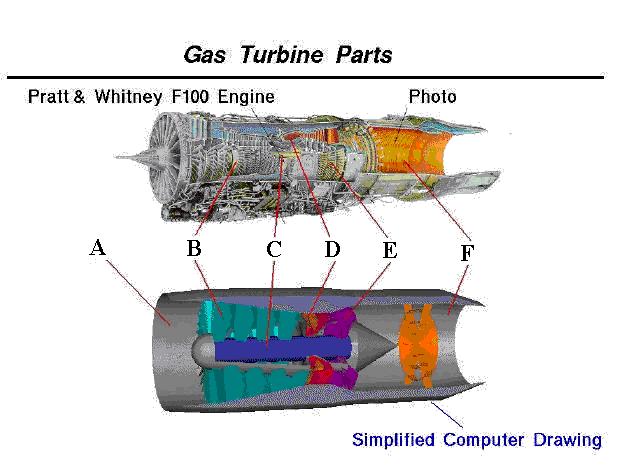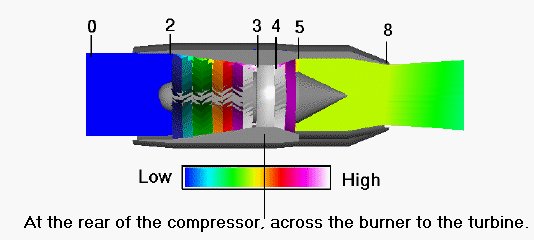
|

|
+ Text Only Site
+ Non-Flash Version
+ Contact Glenn
|
|
|
|
|
Beginner's
Guide to Propulsion
Turbine
Engine Identification
Answers
Answers
will vary. Suggested answers are shown below:

- Use
the Gas Turbine Parts section located in the Propulsion
Index of the Beginner's Guide
to Propulsion to match the correct letter from above with the
listed part. Write the corresponding letter for each part in the space
to the right of the word.
|
Nozzle
|
F
|
|
Turbine
|
E
|
|
Compressor
|
B
|
|
Shaft
|
C
|
|
Burner
|
D
|
|
Inlet
|
A
|
- Answer the following
questions about Turbine Engine Parts and Engine Component
Analysis using the Beginner's
Guide to Propulsion.
- Why is the inlet
lip of a supersonic airplane's engine sharper than the inlet lip of
a subsonic airplane?
The inlet lip is sharpened to minimize
the performance losses from shock waves that occur
during supersonic flight.
- What is the purpose
of the central cone in the "Axisymetric Supersonic" engine?
Some supersonic inlets, like the one at
the upper right,
use a central cone to shock the flow down to subsonic speeds.
- What is the purpose
of the stators in the compressor? Other
rows, called stators, are fixed and do not rotate. The job of the
stators is to both
increase pressure and to keep the flow from spiraling around the axis
by bringing the flow back parallel to the axis.
- What is the advantage
of having a rectangular nozzle on a jet engine?
This allows the exhaust flow to be easily
deflected. Changing the direction of the thrust with the nozzle makes
the aircraft much more maneuverable.
- What is "spillage
drag?" Spillage drag, as the name implies,
occurs when an inlet "spills" air around the outside instead of conducting
the air to the compressor face. The amount of air that goes through
the inlet is set by the engine and can change with altitude and throttle
setting. The inlet is usually sized to pass the maximum airflow that
the engine can ever demand and, for all other conditions, the inlet
will spill the difference between the actual engine airflow and the
maximum air demanded. As the air is spilled over the external cowl
lip, the air is accelerated and the pressure decreases. This produces
a lip suction effect, which partially cancels out the drag due to
spilling.
- What is meant
by "distortion" in reference to inlet performance? As
the air is brought from free stream to the compressor face, the flow
may be distorted by the inlet. At the exit of the inlet (the compressor
face), one portion of the flow may have a higher velocity, or higher
pressure, than another portion. The flow may be swirling or some section
of the boundary layer may be thicker than another section because
of the inlet shape. The rotor blades of the compressor move in circles
around the central shaft. As the blades encounter distorted inlet
flow, the flow conditions around the blade change very quickly. The
changing flow conditions can cause flow separation in the compressor
(a compressor stall) and can cause structural problems for the compressor
blades.
- What
is the difference between an axial compressor and a centrifugal compressor?
The
flow through the axial compressor travels parallel to the axis of
rotation. The flow through the centrifugal compressor is turned perpendicular
to the axis of rotation.
- Why
did designers change from centrifugal compressors to axial compressors?
An
average, single-stage centrifugal compressor can increase the pressure
by a factor of 4. A similar, single-stage axial compressor increases
the pressure by only a factor of 1.2. But it is relatively easy to
link together several stages and produce a multistage axial compressor.
In the multistage compressor, the pressure is multiplied from row
to row (8 stages at 1.2 per stage gives a factor of 4.3). It is much
more difficult to produce an efficient multistage centrifugal compressor
because the flow has to be ducted back to the axis at each stage.
Because the flow is turned perpendicular to the axis, an engine with
a centrifugal compressor tends to be wider (greater cross-sectional
area) than a corresponding axial. This creates additional undesirable
aircraft drag. Centrifugal compressors are also less efficient than
axial compressors.
- At
what point in the turbojet engine is the pressure the highest?

-
How
does the nozzle produce thrust? The
nozzle converts the high pressure and temperature into high velocity.
Because the exit velocity is greater than the free stream velocity,
thrust is created.
|
Related Pages:
Standards
Worksheet
Activity
Propulsion Activity Index
Propulsion Index
|
|
|
|
